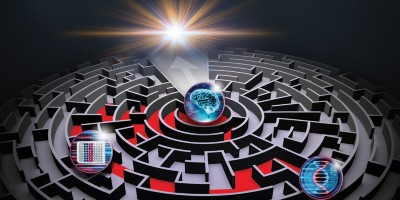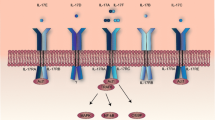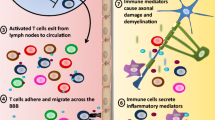Abstract
TH17 lymphocytes appear to be essential in the pathogenesis of numerous inflammatory diseases. We demonstrate here the expression of IL-17 and IL-22 receptors on blood-brain barrier endothelial cells (BBB-ECs) in multiple sclerosis lesions, and show that IL-17 and IL-22 disrupt BBB tight junctions in vitro and in vivo. Furthermore, TH17 lymphocytes transmigrate efficiently across BBB-ECs, highly express granzyme B, kill human neurons and promote central nervous system inflammation through CD4+ lymphocyte recruitment.


Similar content being viewed by others
References
Renno, T. et al. Int. Immunol. 6, 347–354 (1994).
Bettelli, E. et al. J. Exp. Med. 200, 79–87 (2004).
Steinman, L. Nat. Med. 13, 139–145 (2007).
Cua, D.J. et al. Nature 421, 744–748 (2003).
Langrish, C.L. et al. J. Exp. Med. 201, 233–240 (2005).
Sospedra, M. & Martin, R. Annu. Rev. Immunol. 23, 683–747 (2005).
Biernacki, K., Prat, A., Blain, M. & Antel, J.P. J. Neuropathol. Exp. Neurol. 60, 1127–1136 (2001).
Prat, A., Biernacki, K. & Antel, J.P. J. Autoimmun. 24, 119–124 (2005).
Liang, S.C. et al. J. Exp. Med. 203, 2271–2279 (2006).
Chung, Y. et al. Cell Res. 16, 902–907 (2006).
Zheng, Y. et al. Nature 445, 648–651 (2007).
Komiyama, Y. et al. J. Immunol. 177, 566–573 (2006).
Uyttenhove, C. & Van, S.J. Eur. J. Immunol. 36, 2868–2874 (2006).
Wosik, K. et al. J. Neurosci. 27, 9032–9042 (2007).
Acknowledgements
This study was supported by funding from the Multiple Sclerosis Society of Canada (MSSC) and from the Canadian Fund for Innovation to A.P. The animal studies were supported through grants from the US National MS Society and the Swiss National Science Foundation (B.B.). H.K., I.I., A.D.-D. and R.C. hold studentships from the MSSC and the Canadian Institutes of Health Research (CIHR)/Strategic Training Initiative in Health Research Neuroinflammation Training Program. K.K. has a fellowship from the Center for Neurosciences in Zurich. N.A. holds a CIHR Senior Research Fellowship Phase 2. B.B. is a Neuroscience Scholar of the US National MS Society. A.P. is a Research Scholar from the Fonds de la Recherche en Santé du Québec, and holds the Donald Paty Career Award of the MSSC. We thank I. Gutcher, S. Haak, D. Pasichnyk and J. Laganière for their excellent technical assistance. We are grateful to V.K. Kuchroo (Harvard Medical School), who kindly provided the 2D2 mice, and to J.P. Antel (McGill University) for providing assistance and human tissue.
Author information
Authors and Affiliations
Contributions
H.K. conducted most of the experiments; K.K. performed and analyzed animal studies; I.I. and A.D.-D. contributed to immunostaining and in vitro protocols; R.C. assisted with confocal microscopy and performed some EAE experiments; M.B. assisted with BBB-EC isolation and culture; F.G. performed the killing assay; N.A. provided critical input on data analysis; B.B. designed and supervised the animal studies; H.K. and A.P. designed the study, analyzed the data and wrote the manuscript; A.P. secured the funding.
Corresponding author
Supplementary information
Supplementary Text and Figures
Supplementary Methods (PDF 82 kb)
Rights and permissions
About this article
Cite this article
Kebir, H., Kreymborg, K., Ifergan, I. et al. Human TH17 lymphocytes promote blood-brain barrier disruption and central nervous system inflammation. Nat Med 13, 1173–1175 (2007). https://doi.org/10.1038/nm1651
Received:
Accepted:
Published:
Issue Date:
DOI: https://doi.org/10.1038/nm1651
- Springer Nature America, Inc.
This article is cited by
-
The gateway reflex regulates tissue-specific autoimmune diseases
Inflammation and Regeneration (2024)
-
Interleukins in Epilepsy: Friend or Foe
Neuroscience Bulletin (2024)
-
Amelioration of experimental autoimmune encephalomyelitis by in vivo reprogramming of macrophages using pro-resolving factors
Journal of Neuroinflammation (2023)
-
Effects of whole-brain radiation therapy on the blood–brain barrier in immunocompetent and immunocompromised mouse models
Radiation Oncology (2023)
-
Age- and sex-related differences of periodontal bone resorption, cognitive function, and immune state in APP/PS1 murine model of Alzheimer’s disease
Journal of Neuroinflammation (2023)





